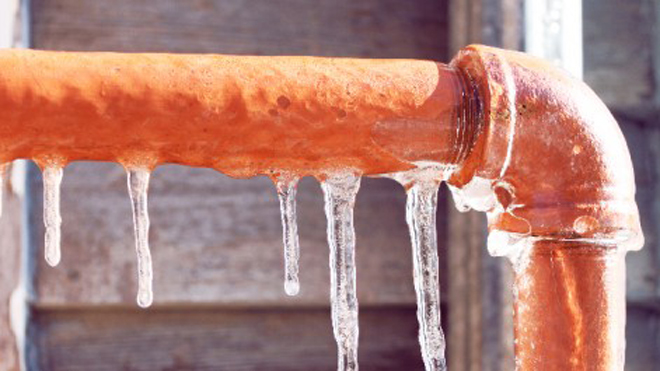Preventing Frozen Plumbing in Winter: Critical Advice
Preventing Frozen Plumbing in Winter: Critical Advice
Blog Article
We've unearthed the article about 6 Ways to Prevent Frozen Pipes directly below on the internet and accepted it made sense to quickly share it with you on this page.
:strip_icc()/snow-outdoor-faucet-pipes-4af65d1e5e904fb1aa7bf74071fe5d89.jpg)
Cold weather can damage your plumbing, especially by freezing pipes. Right here's how to stop it from occurring and what to do if it does.
Intro
As temperatures decrease, the danger of icy pipes increases, possibly resulting in pricey repairs and water damage. Understanding exactly how to avoid icy pipes is important for property owners in cold environments.
Understanding Icy Pipes
What creates pipes to ice up?
Pipes freeze when revealed to temperatures listed below 32 ° F (0 ° C) for extended durations. As water inside the pipes freezes, it increases, putting pressure on the pipe wall surfaces and potentially triggering them to break.
Threats and damages
Frozen pipelines can lead to supply of water disturbances, home damages, and pricey fixings. Burst pipes can flood homes and cause comprehensive structural damage.
Signs of Frozen Pipeline
Determining frozen pipes early can prevent them from bursting.
How to recognize icy pipelines
Search for reduced water flow from taps, unusual smells or noises from pipes, and visible frost on exposed pipes.
Avoidance Tips
Shielding susceptible pipes
Cover pipes in insulation sleeves or make use of warmth tape to shield them from freezing temperature levels. Concentrate on pipelines in unheated or exterior areas of the home.
Home heating methods
Keep interior areas appropriately heated up, especially locations with pipes. Open closet doors to enable cozy air to distribute around pipes under sinks.
Safeguarding Exterior Plumbing
Yard hoses and exterior faucets
Disconnect and drain pipes garden tubes before wintertime. Install frost-proof spigots or cover outdoor faucets with shielded caps.
What to Do If Your Pipes Freeze
Immediate actions to take
If you believe frozen pipes, maintain taps available to relieve stress as the ice melts. Use a hairdryer or towels soaked in hot water to thaw pipelines gradually.
Long-Term Solutions
Structural modifications
Think about rerouting pipes away from outside wall surfaces or unheated areas. Include added insulation to attic rooms, basements, and crawl spaces.
Updating insulation
Purchase premium insulation for pipes, attic rooms, and wall surfaces. Correct insulation assists preserve constant temperature levels and reduces the risk of icy pipelines.
Verdict
Protecting against icy pipes requires aggressive actions and fast actions. By comprehending the reasons, signs, and safety nets, homeowners can secure their pipes throughout cold weather.
5 Ways to Prevent Frozen Pipes
Drain Outdoor Faucets and Disconnect Hoses
First, close the shut-off valve that controls the flow of water in the pipe to your outdoor faucet. Then, head outside to disconnect and drain your hose and open the outdoor faucet to allow the water to completely drain out of the line. Turn off the faucet when done. Finally, head back to the shut-off valve and drain the remaining water inside the pipe into a bucket or container. Additionally, if you have a home irrigation system, you should consider hiring an expert to clear the system of water each year.
Insulate Pipes
One of the best and most cost-effective methods for preventing frozen water pipes is to wrap your pipes with insulation. This is especially important for areas in your home that aren’t exposed to heat, such as an attic. We suggest using foam sleeves, which can typically be found at your local hardware store.
Keep Heat Running at 65
Your pipes are located inside your walls, and the temperature there is much colder than the rest of the house. To prevent your pipes from freezing, The Insurance Information Institute suggests that you keep your home heated to at least 65 degrees, even when traveling. You may want to invest in smart devices that can keep an eye on the temperature in your home while you’re away.
Leave Water Dripping
Moving water — even a small trickle — can prevent ice from forming inside your pipes. When freezing temps are imminent, start a drip of water from all faucets that serve exposed pipes. Leaving a few faucets running will also help relieve pressure inside the pipes and help prevent a rupture if the water inside freezes.
Open Cupboard Doors
Warm your kitchen and bathroom pipes by opening cupboards and vanities. You should also leave your interior doors ajar to help warm air circulate evenly throughout your home.

I hope you enjoyed our excerpt on Prevent Frozen Pipes . Thanks so much for taking the time to browse our short article. Be sure to take a moment to share this page if you appreciated it. Thank you so much for taking the time to read it.
Go Company Report this page